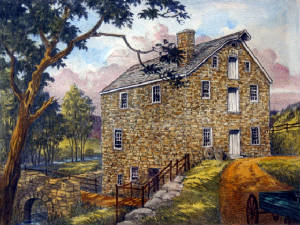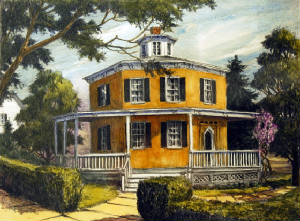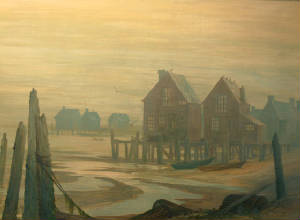|
Lucille Hobbie (1915- 2008)
A painter, printmaker, watercolorist, and lithographer, Lucille
Hobbie was also a teacher, administrator, and winner of the Arts Council’s Outstanding Professional in the Arts Award
(2002). Hobbie was known to have said, "I hope someday I'll become the painter I'd like to be.”
Born in Boonton in 1915, she knew from the first she wanted to be an artist.
As she explained, “I saw so much and wanted so badly for everyone else to see it.” After her mother's death, she
moved to New York, where her work was soon recognized. The self-taught artist had many one-woman shows at the prestigious
Morton and 8th Street galleries. Early supporters included the New York Times art editor; before long she was exhibiting
throughout the East Coast. With her painter husband Albert Heimrod, she moved to Newark, where they ran the Newark Art Club,
and then returned to Morris County, settling in Mendham. They worked for 10 years with the Newark Board of Educa-tion's Saturday
Children's Art School; she was simultaneously a teacher and administrator for the Newark School of Fine and Industrial Arts.
Hobbie was both a painter and a printmaker. Her first love was
watercolor, but she worked extensively in lithography and also used casein, acrylic, pen and ink, and pencil. History was
a strong theme in her work, which depicts farmsteads, fishing villages, and other elements of a vanishing American landscape.
She is particularly well known for "Historic Morris County," a series of lithographs including the Wick House in Jockey Hollow,
Hilltop Church in Mendham, and Acorn Hall.
Her award-winning work is in the permanent collections of numerous
museums as well as corporate settings, including: the Montclair Art Museum, Colonial Williamsburg, the Newark Public Library
Print Collection, the Seeing Eye, Nabisco, and others. She was a member of the National Society of Arts and Letters and the
American Watercolor Society, and a lifetime member and former president of the New Jersey Watercolor Society. She had strong
ties to the Morris County Heritage Commission and the Morris County Historical Society. Over the years, she donated many works
and a portion of print sales to charitable causes, especially those dedicated to historic and natural conservation. She died
in 2008.

|
| Click picture to enlarge |
Lucille
Hobbie
General
Cooper Grist Mill
Date
unknown
Hand-colored
lithograph
12
x 9 1/4 in.
Gift
from William F. Hobbie.
The
General Cooper Grist Mill was built in 1826 by Nathan Cooper and included some of the newest innovations of the time. These
techniques were the design of inventor Oliver Evans, whose ideas of automation revolutionized the milling process. His book,
The Young Mill Wright's and Miller's Guide, detailed how to use elevators, moving belts, and screw conveyors to make
a milling operation more efficient and profitable. Some of this technology can be seen in the Cooper Mill today.

|
| Click picture to enlarge |
Lucille Hobbie
The Garrett-Rickards House: Boonton, NJ
Date unknown
Hand-colored lithograph
12 x 9 in.
Gift from William F. Hobbie.
The Garrett Rickards House, located at 211 Cornelia Street in Boonton, NJ, was
built in 1854 according to the instructions in A Home for All, or the Gravel Wall and Octagon Mode of Building, written
by Orson Squire Fowler. Fowler proposed the octagonal shape as the most efficient way of utilizing floor and wall space, while
at the same time providing the largest amount of sunlight. Rickards adapted Fowler's formula for reinforced concrete by using
slag from the iron works instead of gravel.

|
| Click picture to enlarge |
Lucille Hobbie
Morning Tide
Circa 1960s
Watercolor on board
28 1/2 x 21 1/2 in.
Gift from the family of Nina Kummel.
|

